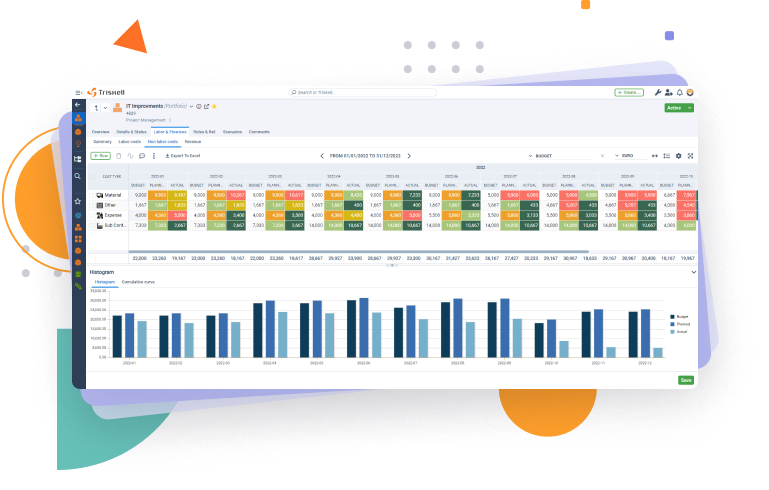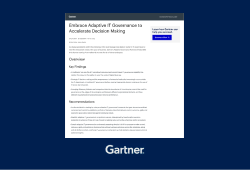
10 types of Project Management Offices (PMO): structure, purpose and how to choose the right one
Learn about different PMO types, their governance levels, and which one is the best fit for your company’s project management needs.
Project portfolio management is a discipline that is constantly evolving. In recent years, as a result of the rise of agile methodologies and the new ways of working brought by the digital era, changes in the management of the organisation’s portfolio have become much more evident.
As project portfolio management is no longer the same as it was 10 years ago, every PPM software available on the market must also change. These solutions must be renewed and new functionalities added in order to address the new challenges and needs of the companies that have emerged as a result of this new context.
Unfortunately, not all PPM software has been able to adapt to the new trends and practices that have emerged in project portfolio management. And it is very likely that your solution is one of the many that has become obsolete for efficient project portfolio management. Want to find out? These are the reasons why your current PPM solution is already outdated and you should change it as soon as possible.
TABLE OF CONTENTS
The digital era has brought with it many changes in the day-to-day operations of many companies. And portfolio management is far from being exempt from this global context. We have much more competitive markets, with more and more competitors. Consumers are becoming more and more demanding, asking for products and services that are increasingly innovative and tailored to their needs.
The life cycles of products and services are therefore becoming shorter and shorter. This forces organizations to have to meet the demand in their markets and to reformulate their strategic objectives in ever shorter timeframes.

PROJECT PORTFOLIO MANAGEMENT
Is your PPM tool holding you back?
Discover Triskell’s PPM solution.
In this context, aligning strategy planning with execution is the major challenge for the success of organizations. Many of them fail to achieve their strategic objectives because they do not have the right processes and tools to align their portfolio of projects or products with the company’s goals. This leads to a loss of focus on key portfolio management issues such as prioritization of initiatives, resource management, financial management, or risk management. This results in a portfolio that is not aligned with the organization’s strategic planning.
Unfortunately, many of the PPM tools available on the market do not have the functionality to align the IT portfolio with the organization’s objectives in real-time. The absence of a strategic vision in your decision-making processes has surely already had consequences in your organization such as:
Therefore, for efficient management of the IT portfolio, it is necessary to have a solution that also covers the strategy execution management of the portfolio. This is the only way you will be able to respond from your IT department to the strategic and governance challenges that will arise during the management and execution of your portfolio.
Many organizations do not have the processes and tools in place to align the portfolio with their objectives
And, at this point, you are probably wondering: how can I know if it is time to replace the PPM solution we are using in the IT department? If you are aware that your department finds challenging to align with the strategic objectives of the business, in your day-to-day use of PPM software, you will detect signs that will indicate that this solution does not cover the management of strategy execution.
Specifically, there are 5 aspects of the PPM software to which you need to pay special attention. They are as follows:
We will explain in detail how to identify each of them below.
The current context compels organizations to have, at the portfolio level, processes and tools to be able to face the strategic and governance challenges that may arise with guarantees. In order not to lose competitiveness, organizations may be forced to review and redefine their strategic vision and objectives every 3 to 6 months.
Organizations should redefine their objectives and strategy every 3 – 6 months
To respond efficiently and effectively to these changes in the organization’s course, you need to make sure that with the PPM solution you can perform the following actions:
Therefore, at this point, to find out if the PPM software you use in your organization is able to meet the strategic and governance challenges of portfolio management, you should ask yourself the following questions:
If the answer to any of these questions is no, then you already know that your PPM software does not cover the planning of strategy execution management.
Ready to see the difference? Request a free demo today!
Tired of struggling with your current PPM software? See how Triskell can streamline your projects and boost team efficiency
Project portfolio management has experienced many changes over the last 10 years. Previously, the priority was to complete projects within the deadlines and budgets agreed with the different stakeholders of the organization, without taking into account variables that today are essential for efficient portfolio management, such as, for example:
Today, it is recommended an adaptive PPM approach for efficient portfolio management. This implies the implementation of processes and tools that your PMO can use to adapt resource management, budget or portfolio priorities in an agile manner in accordance with changes in the organization’s strategic objectives and vision.
Many PPMs do not have the ability to manage the portfolio with an adaptive approach
Many PPMs do not have the capability to manage the portfolio with an adaptive approach. How to identify it? You should ask yourself the following questions. And if the answer to any of them is no, then your PPM solution is not set up to manage the portfolio adaptively.
One of the biggest challenges in portfolio management is to have processes and tools in place to predict and plan for the long-term capacity of the organization’s resources.
Capacity planning is a step beyond resource management in the more conventional meaning of the term. While resource management is more oriented to the efficient allocation of short-term resources at the department or project level, capacity planning is performed at the portfolio level. It focuses on thoroughly studying the demand and the organization’s capacity to:
The benefits you will gain from capacity planning are countless: investing resources in the projects that provide the most value to the organization, improved ability to manage changes in the organization’s objectives, talent retention, higher productivity, etc. Therefore, for efficient management of the organization’s resources, it is necessary to carry out capacity planning. And your PPM software needs to have the functionality to efficiently manage both, resource management and capacity planning.
Efficient resource management requires capacity planning
How can you know if your solution is designed for capacity planning? You should ask yourself the following questions:
If the answer to any of these questions is no, then your PPM solution does not efficiently cover capacity planning.
PPM SOFTWARE CHECKLIST
A Comprehensive buyer’s checklist for PPM Software
Use this quick checklist to compare potential modern PPM solutions in order to pick the best one for your organization.
The coexistence, within the same organization, of different work methodologies has made project portfolio management even more complex.
While the more traditional portfolio management was based on the Waterfall methodology, in which the management of each project or program was divided into a linear process divided into phases, the emergence of agile methodologies has implied several fundamental changes in portfolio management:
Efficient resource management requires capacity planning
They are not opposing approaches; both can (and should) coexist within organizations. And the biggest challenge for both project portfolio management and PPM software in the market is to enable the right processes and tactics to implement a Hybrid portfolio management model.
However, not all PPM software has the same flexibility in adopting this hybrid management approach. And the reason is that many of them were designed with only the traditional waterfall approach to portfolio management in mind. To find out if your PPM is the right one to adapt to this new hybrid management model, you must answer affirmatively to the following questions:
Is it a flexible tool that allows you to pivot easily when prioritizing and changing the status of each of the initiatives in your portfolio?
You already know that for efficient project portfolio management it is necessary that the tools you use can be integrated with each other in a simple and agile way. Being able to integrate the tools with which you plan, manage and execute your portfolio brings many advantages:
Having a PPM in which you can integrate other key tools in other aspects of portfolio management is fundamental. The problem is that most of the PPMs on the market are particularly complex when it comes to integrating with other software that you have implemented internally in your organization, which makes it even more difficult to manage the portfolio efficiently.
Many PPM software are complex to integrate with other tools
You must ensure that you do not face any of these issues with the PPM solution you have in place:
More and more PPM tools are designed to integrate with other software in an agile and simple way, without requiring the help of an external development team or a strong coding knowledge. If this is not your case, then it is time to change your PPM software.
And, as a bonus, we give you one more reason why you should renew the PPM software with which you manage the organization’s project portfolio. You should know that some of the software vendors specialized in the PPM market are no longer investing money in their solutions.
This is a particularly delicate issue, as many of these software vendors do not mention it. And you may be in for an unpleasant surprise if you purchase one of these solutions and find that you are not going to receive the support that you and your organization deserve.
Many PPM software vendors no longer invest in their solutions
This lack of investment can be detected in several ways. Here is a list of the most common ones. And, if you identify any of them, then you will need to consider seriously purchasing a new PPM software:
At this point, you are probably asking yourself this question: which PPM software best suits my organization’s needs? As you have seen through this post, there are many factors that can affect your user experience with the solution you choose, so it is a decision that should be carefully considered.
EBOOK
PPM Software Buyers’ Guide
What should you look for in a new PPM tool?
When choosing one PPM software or another, it is important that you follow a process that will help you define the type of solution you need and the functionalities it should include. From Triskell Software we recommend you to carry out, at least, these 4 actions to take the most appropriate decision:
In the following post, “How to choose the right PPM software for your IT department”, we give you these and other steps to follow to help you choose the solution that best fits your organization’s needs.
SUBSCRIBE TO OUR NEWSLETTER
Get stories like this in your inbox
Request a demo of Triskell Software
Triskell Software is the flexible solution you need to align portfolio management and execution with your organization’s goals and strategic vision. Check it out for yourself by requesting a demo.

Related Content

10 types of Project Management Offices (PMO): structure, purpose and how to choose the right one
Learn about different PMO types, their governance levels, and which one is the best fit for your company’s project management needs.

How to create a project budget: methods and techniques for effective project budgeting
Learn how to create a project budget with this detailed guide. Discover essential methods and techniques for effective project budgeting in PPM.

20 strategic planning models and tools for medium and large companies
Looking for the best strategic planning frameworks? This guide covers 20 proven models to enhance decision-making and business growth.
Solutions
Platform
Company
Compare Triskell
© 2025 Triskell Software. All Rights Reserved.
Legal Notice
Privacy Policy
Cookies policy
Quality Management and Information Security System Policy

We use technologies such as cookies to store and/or access device information. We do this to improve the browsing experience and to display (non-) personalized advertisements. Consenting to these technologies will allow us to process data such as browsing behavior or unique ID's on this site. Not consenting, or withdrawing consent, may adversely affect certain features and functions.

Embrace Adaptive IT Governance to Accelerate Decision Making
Traditional IT governance is holding businesses back. This Gartner report introduces a flexible, outcome-driven governance model designed for speed, agility, and enterprise-wide impact.
Download now and learn how to modernize decision making across your organization.